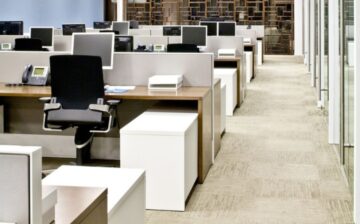
An office relocation is a big job. Depending on the size of your office, it can be even more involved than packing and moving your house. There may be dozens or hundreds of desks, chairs, conference tables, and computers and monitors. Not to mention specialized equipment your business depends on, along with posters, break room tables, and office supplies.
Like any large undertaking, the key to a successful office move is to break it down into smaller tasks. Looking at each task at a time makes it much more manageable. This post will tell you what’s involved in an office move. This information might help you if you’re considering moving your office.
What Does an Office Move Involve?
An office move means packing and relocating your office property and getting it all up and running in the new location. What can make it more complicated than a home move is that:
- There may be more furniture and other items, especially delicate electronics, than in a typical home
- You need a moving company that is skilled in commercial moves
- You have to coordinate the move with your company’s staff
Start With a Moving Team
Unless you have a very small business or most of your employees work remotely, you probably cannot take on all of the moving tasks yourself. So you will want to appoint a moving team from within your company. This will help you get your employees’ buy-in and representation from every major department.
Inspect Your New Office
Scoping out your new office will help you decide what to move and what will not fit. Instead of spending time, effort, and funds to transport items you can’t use, you’ll want to take measurements ahead of time so you’ll know what to pack before you move. It may be nice to bring along the big conference room table, but first, you’ll want to make sure your new conference room will accommodate it or if it will even fit through the doorway.
While you’re inspecting your new office, you’ll also want to become familiar with any rules about moving. Maybe you can only move on weekends, park at certain locations at certain times, or need to reserve the freight elevator in advance. These are things the moving company will need to know.
Even better will be to bring your moving team to walk through the new office together. If you can get a digital floor plan, you can use online tools to plan what to put where. Your employees can provide suggestions on designing the new layout.
If there are any items you can’t bring with you, arrange to sell or donate them. You could hold an office sale or arrange for a charitable organization to do a pickup.
Decide on a Moving Budget
Although your budget may change, you will want to have a general budget. This will help you when choosing a moving company and deciding what to move and what not to.
Find a Suitable Moving Company
You will need to look for companies with experience in office moves. A reputable moving company will work with you on a suitable moving date, the specifics of your move, and your needs and budget. You’ll want to choose several candidates and then contact each company to get a quote and discuss your moving needs.
Clean Your Old Office
Your current lease will specify what you must do after vacating, such as cleaning, painting, and repairing. Landlords generally expect your office to be left in a similar condition as when you moved in. If it’s not, you may forfeit your security deposit.
Inform Your Staff
You’ll want to inform your entire staff about the move, including those who are working remotely. You’ll want to keep the lines of communication open through email and periodic meetings to address any questions and concerns.
Update Your Address
You’ll need to update your address on your office documents, stationery, website, and social media accounts. You’ll also need to notify company stakeholders like investors, customers, and vendors of your move and your new address.
Load and Move
On moving day, someone from your office must be at both locations to open the doors for the movers and oversee the move. This means pointing out what needs to be loaded first and what last, what needs to be placed where, and any fragile items that need special handling.
Create an IT Transfer Plan
You’ll need to disconnect your servers and network and set them up at your new office. Then you’ll need to test everything to ensure they’re all working before you start using them in your business.
This post has described what is typically involved in an office move. You’ll want to tailor and add this list for your specific move. The keys to a successful office relocation are to start planning early, break the move down into smaller tasks, and delegate some jobs to the moving team.
We hope you found this post, What is Involved in an Office Move? useful. Be sure to check out our post, Commercial Moving Basics – How You Can Manage an Office Move for more great information.
Have Experience in the Moving Industry? Want an Additional Income Stream? Work With All Around Moving!
Partner with us and join the Work With Us program, and we’ll help you make money by establishing your own moving consultant business. Read the terms by Clicking here to learn more.





